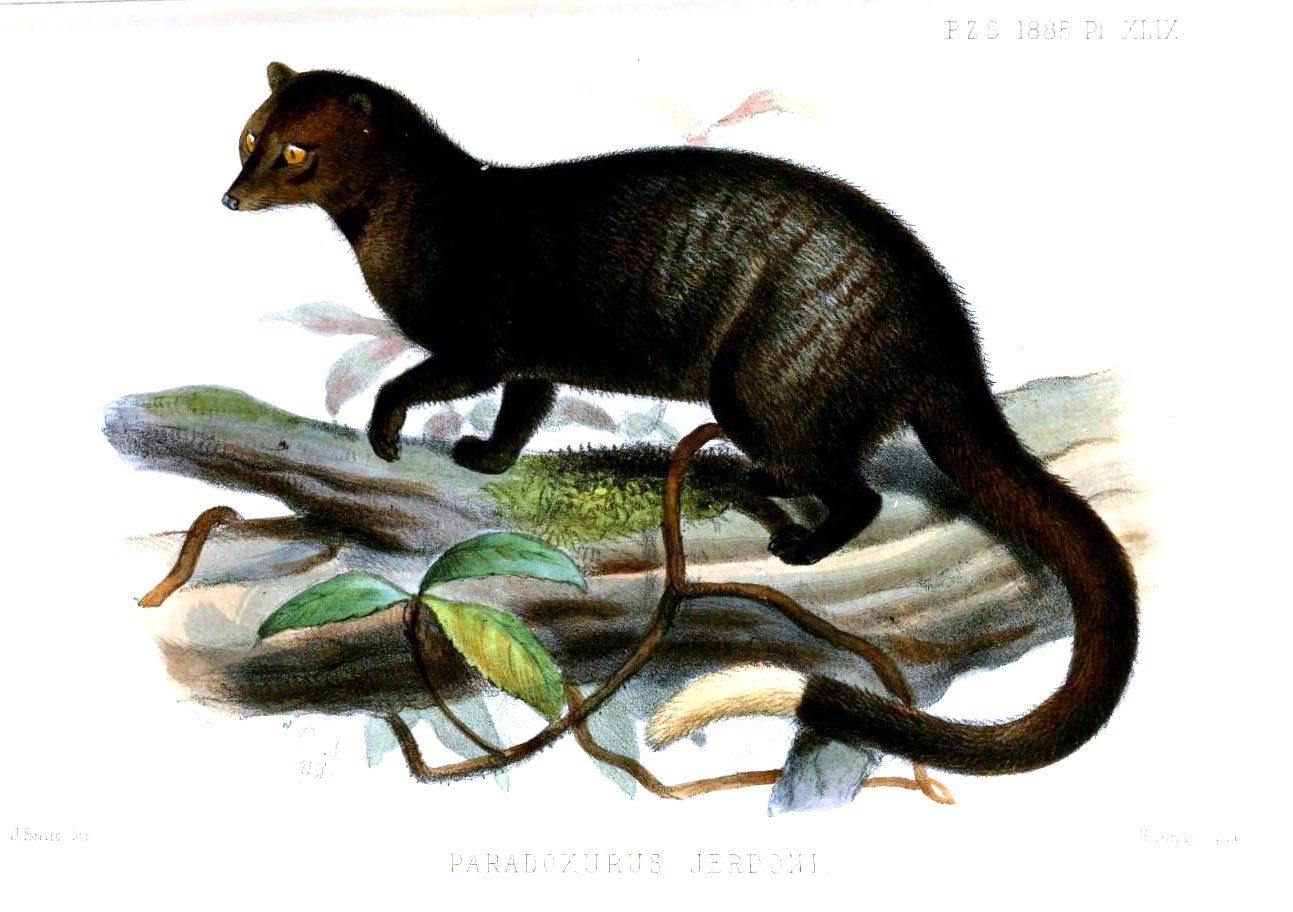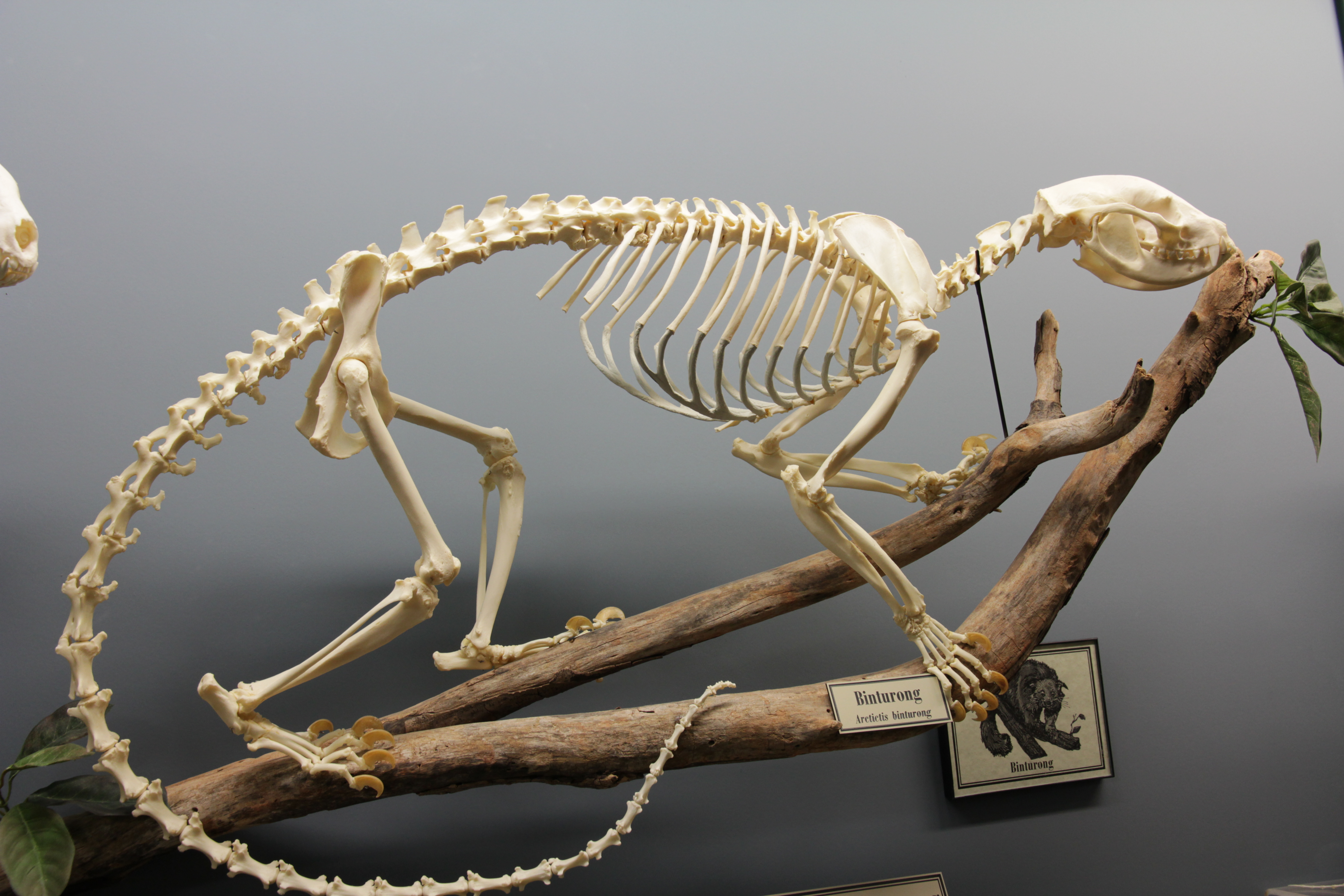|
Paradoxurus
''Paradoxurus'' is a genus of three palm civets within the viverrid family that was denominated and first described by Frédéric Cuvier in 1822. The ''Paradoxurus'' species have a broad head, a narrow muzzle with a large rhinarium that is deeply sulcate in the middle. Their large ears are rounded at the tip. The tail is nearly as long as the head and body. The three species are the Asian palm civet, the Golden palm civet, and the Brown palm civet. Characteristics ''Paradoxurus'' species have a broad head, a narrow muzzle with a large rhinarium that is deeply sulcate in the middle. Their large ears are rounded at the tip, the interior ridges and bursae are well developed. The skull exhibits marked muscular moulding, and the postorbital area is deeply constricted shortly behind the well-developed postorbital processes. It is considerably narrower than the interorbital area and than the muzzle above the canines. The dental formula is . The palate is not produced behind to co ... [...More Info...] [...Related Items...] OR: [Wikipedia] [Google] [Baidu] |
Asian Palm Civet
The Asian palm civet (''Paradoxurus hermaphroditus''), also called common palm civet, toddy cat and musang, is a viverrid native to South and Southeast Asia. Since 2008, it is IUCN Red Listed as Least Concern as it accommodates to a broad range of habitats. It is widely distributed with large populations that in 2008 were thought unlikely to be declining. It is threatened by poaching for the illegal wildlife trade. Characteristics The Asian palm civet's long, stocky body is covered with coarse, shaggy hair that is usually greyish in colour. It has a white mask across the forehead, a small white patch under each eye, a white spot on each side of the nostrils, and a narrow dark line between the eyes. The muzzle, ears, lower legs, and distal half of the tail are black, with three rows of black markings on the body. Its head-to-body length is about with a long unringed tail. It weighs . Its anal scent glands emit a nauseating secretion as a chemical defense when threatened or ... [...More Info...] [...Related Items...] OR: [Wikipedia] [Google] [Baidu] |
Brown Palm Civet
The brown palm civet (''Paradoxurus jerdoni''), also called the Jerdon's palm civet, is a viverrid endemic to the Western Ghats of India. Taxonomy The scientific name ''Paradoxurus jerdoni'' was introduced by William Thomas Blanford in 1885 who described a skull and pelt of a brown palm civet collected in Kodaikanal. Blanford noted the long foramen on the anterior palate and also that the pelt matched another zoological specimen collected by Francis Day. Blanford named the species in honour of Thomas C. Jerdon. The subspecies ''caniscus'' was described by Reginald Innes Pocock on the basis of a specimen collected at Virajpet in southern Coorg. There are two subspecies, the nominate ''P. j. jerdoni'' and ''P. j. caniscus''. Characteristics The brown palm civet has a uniformly brown pelage, darker around the head, neck, shoulder, legs, and tail. Sometimes the pelage may be slightly grizzled. Two subspecies have been described on the basis of the colour of the pelage ... [...More Info...] [...Related Items...] OR: [Wikipedia] [Google] [Baidu] |
Paradoxurus Aureus
The golden palm civet (''Paradoxurus zeylonensis'') is a viverrid endemic to Sri Lanka. It is listed as Least Concern on the IUCN Red List since 2016.The extent and quality of its habitat in Sri Lanka's hill regions are declining. The golden palm civet was described by Peter Simon Pallas in 1778. Taxonomy ''Viverra zeylonensis'' was the scientific name proposed by Peter Simon Pallas in 1778 for a palm civet specimen from Sri Lanka. Between the 19th and early 21st centuries, several zoological specimens were described, including: *''Paradoxurus aureus'' by Frédéric Cuvier in 1822 *''Paradoxurus montanus'' by Edward Frederick Kelaart in 1852 who described a fulvous brown palm civet from the mountains of Sri Lanka, which he considered a variety of the golden palm civet. *''Paradoxurus stenocephalus'' by Colin Groves and colleagues in 2009 who described a golden brown specimen from Sri Lanka's dry zone. They proposed to regard ''P. montanus'', ''P. aureus'' and ''P. stenocephalus ... [...More Info...] [...Related Items...] OR: [Wikipedia] [Google] [Baidu] |
Viverridae
Viverridae is a family (biology), family of small to medium-sized feliform mammals, comprising 14 genera with 33 species. This family was named and first described by John Edward Gray in 1821. Viverrids occur all over Africa, in southern Europe, South Asia, South and Southeast Asia on both sides of the Wallace Line. The word viverridae comes from the Latin word . The species of the subfamily Genettinae are known as Genet (animal), genets and Poiana (genus), oyans. The viverrids of the subfamily Viverrinae are commonly called civets; the Paradoxurinae and most Hemigalinae species are called palm civets. Characteristics Viverrids have four or five toes on each foot and half-retractile claws. They have six incisors in each jaw and Molar (tooth), molars with two tubercular grinders behind in the upper jaw, and one in the lower jaw. The tongue is rough with sharp prickles. A pouch or Anal gland, gland occurs beneath the anus, but there is no cecum. The male's Urinary meatus, urethr ... [...More Info...] [...Related Items...] OR: [Wikipedia] [Google] [Baidu] |
Colin Groves
Colin Peter Groves (24 June 1942 – 30 November 2017) was a British-Australian biologist and anthropologist. Groves was professor of biological anthropology at the Australian National University in Canberra, Australia. Education Born in England, Groves completed a Bachelor of Science at University College London in 1963, and a Doctor of Philosophy at the Royal Free Hospital School of Medicine in 1966. From 1966 to 1973, he was a postdoctoral researcher and teaching fellow at the University of California, Berkeley, Queen Elizabeth College and the University of Cambridge. Career Groves emigrated to Australia in 1973 and joined the Australian National University, where he was promoted to full professor in 2000 and remained emeritus professor until his death. Along with the Czech biologist Professor Vratislav Mazák, Groves was the describer of ''Homo ergaster''. Groves also wrote ''Primate Taxonomy'' published by the Smithsonian Institution Press in 2001, and ''Ungulate Taxono ... [...More Info...] [...Related Items...] OR: [Wikipedia] [Google] [Baidu] |
Endemic
Endemism is the state of a species being found only in a single defined geographic location, such as an island, state, nation, country or other defined zone; organisms that are indigenous to a place are not endemic to it if they are also found elsewhere. For example, the Cape sugarbird is found exclusively in southwestern South Africa and is therefore said to be ''endemic'' to that particular part of the world. An endemic species can also be referred to as an ''endemism'' or, in scientific literature, as an ''endemite''. Similarly, many species found in the Western ghats of India are examples of endemism. Endemism is an important concept in conservation biology for measuring biodiversity in a particular place and evaluating the risk of extinction for species. Endemism is also of interest in evolutionary biology, because it provides clues about how changes in the environment cause species to undergo range shifts (potentially expanding their range into a larger area or bec ... [...More Info...] [...Related Items...] OR: [Wikipedia] [Google] [Baidu] |




